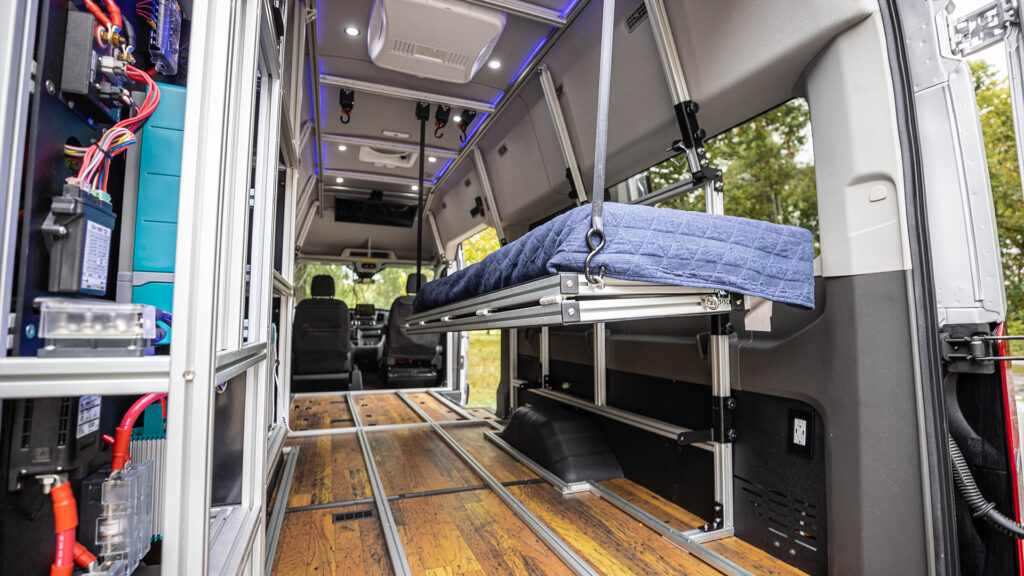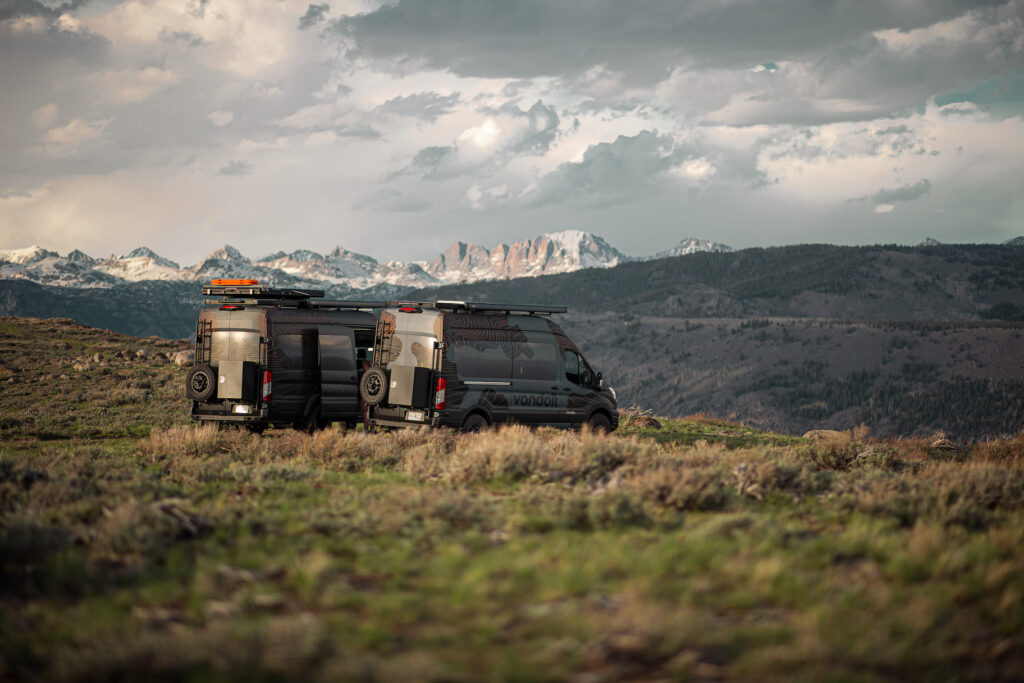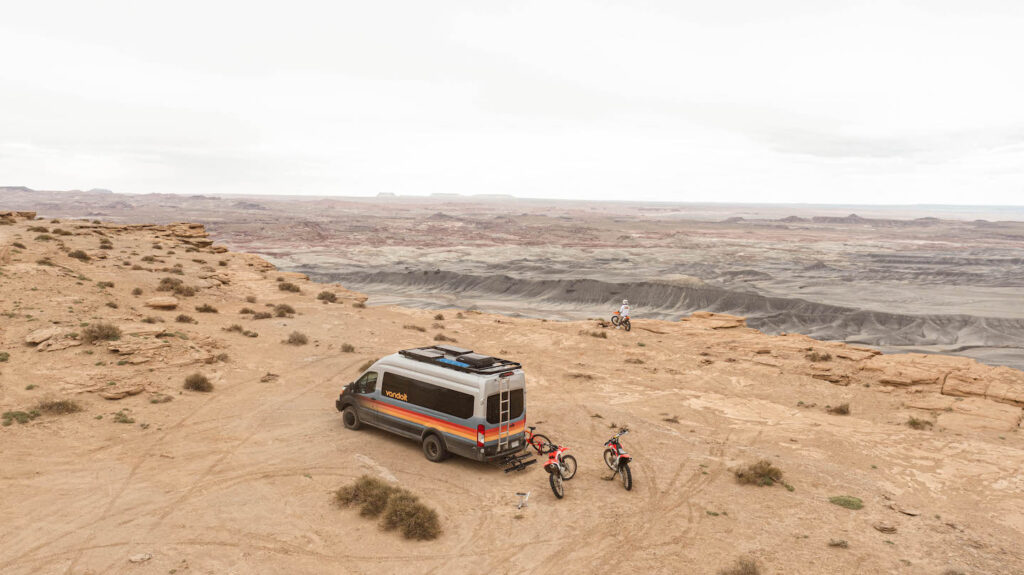If you’ve spent any time researching the purchase of an RV, you’ve undoubtedly come across an ad or Youtube video about a camper van.
Camper vans aren’t truly new to the market (think 60s VW hippie van), but they’ve taken off in recent years. This was especially true during the height of the Covid pandemic when everyone was looking for a safe way to stay at home while itching to not be at home. Traveling the country in a van or an RV was an appealing way to get out and enjoy the world while still avoiding getting sick or spreading germs.
Now that Covid restrictions have been lifted, many people who jumped on the camper van bandwagon are discovering that it’s not just a way to escape quarantine but a new way of life. And many find that their nomadic lifestyle is more sustainable in a camper van than in an RV.
So if you’re ready to launch into your own nomadic lifestyle but are unsure whether an RV or a camper van is right for you, we have a few reasons why a camper van is the way to go. (And yes, we’re a little biased. But we’re also confident that we make a pretty amazing van.)
1: Size

An obvious reason to go with a camper van is the size. A camper van is just that – a van and a class B vehicle that can still fit in a standard parking space. The Ford Transit, which is the platform Vandoit builds on, is 19.6 feet (long chassis) or 22 feet long (EL chassis) and just over 8 feet wide, compared to an RV that can be up to 41 feet long and 2 to 3 feet wider than a van.
Vans are easier to park and back up and handle more like an SUV than you might think. So when you arrive at your campsite after dark, you can roll right in with your van rather than having to maneuver a large RV into the campsite.
Many people who go the RV route opt for a pull-behind trailer or fifth wheel. These RVs come with their own logistical challenges, from hooking and unhooking from the hitch, leveling, backing into a parking spot, and storage. Not to mention that it requires another vehicle altogether to tow it. With a campervan, especially the Ford Transit, towing is your choice, not a necessity.
In fact, if you’re worried a van won’t give you enough room to store all your toys like bikes and kayaks, the Transit standard factory tow package allows you to tow those items behind the van, and you can always opt to add a Thule bike rack for easy exterior storage.
2: Offroad Capabilities
Because the camper van is smaller and has a lighter load capacity, it can go places RVs simply can’t go, like washboard roads or offroad altogether. You can travel to even more hard-to-reach destinations when you add options to your camper van, like all-terrain tires, upgraded suspension, and the Quigley QLift. So, rather than parking your RV and hiking to see the sunset from a canyon vista, why not just park at the vista?

3: Camper Van Modularity
Camper vans clearly have less interior room than RVs do – an important limitation to consider while shopping for your next adventure vehicle. But with Vandoit’s modular design, you can have all the comforts an RV offers, just in simplified form. And by modular, we mean that your kitchen, water system, and rear passenger seats aren’t permanently installed. You can move them around in the van or remove them altogether.
How many RVs allow you to move furniture like that, much less an entire system? And how many other camper vans allow you to do that at all?
4: Multifunctionality
Because of Vandoit’s modular design, your van can be truly multifunctional.
One weekend, you can install all the seats to haul the kids to basketball practice. The next, you can remove the seats, load in the outdoor gear, and lower the beds for a camping trip. And during the week, you can remove everything to haul cargo for work and construction materials for that home DIY project.
In fact, so many Vandoit owners use their vans for both pleasure and business, it made a lot of sense for Vandoit to launch a Commercial Van Division in 2023. This multifunctionality is a feature that not only sets Vandoit apart from RVs, but apart from other camper van builders, too.
5: System Simplicity
This is a HUGE one. The simplicity of camper van systems, especially water and electrical, in comparison to RV systems is a plus we can’t emphasize enough. We could go on all day about this one, but we’ll save you with a few handy bullet points instead.
- In an RV, bleach and other chemicals are needed to treat the water tanks. In a camper van, bleach is still an option for a when-you-need-it cleaning job, but a good water and vinegar solution will do in the Vandoit water system.
- The gray water tank in an RV has to be emptied using a multistep process, hoses, and a gray water dump site. In a Vandoit, just remove the gray water tank, dump at an appropriate site, and re-install.
- RVs have black water (sewage) tanks that can be a pain to drain, not to mention a potential health hazard. Vandoit has no sewage system to deal with at all. Instead, you have the option to use a dry-flush toilet, which operates in a clean, mess-free fashion. (Think diaper genie.)
- Most RVs require a water pressure regulator. Since the Vandoit water system requires no hookup, no regulator is needed. It’s a simple, self-contained system.
- Winterizing (and de-winterizing) the water system in an RV is a laborious, multistep process that can take hours. It requires adding gallons of antifreeze and removing water filter cartridges, among other things. De-winterizing requires sanitizing the water lines with bleach and waiting for hours before draining and using the water system. Winterizing the water system in a campervan is often much more straightforward. In fact, winterizing the Vandoit water system involves only a handful of simple steps, depending on the model of your van.
- The electrical system in an RV can be complex and confusing, especially when it stops working the way it’s supposed to. Depending on where you purchase your RV, you may not have support from the RV dealer to troubleshoot these electrical issues. The Vandoit Support Team is available to work with you to troubleshoot your issues and get your system up and running in no time. The team has even published a catalog of Knowledge Base Articles that may provide just the instruction you need to troubleshoot and resolve an issue on your own!
- Unlike an RV’s electrical system, there is no need to add water to lead-acid batteries in the Vandoit electrical system. In fact, there is little maintenance to do on the batteries at all, aside from monitoring the voltage levels and making sure they stay well charged to preserve cycle life.
- When setting up at a campsite, every RV requires water and electrical hookups. The Vandoit water system, on the other hand, requires no hookup, and an electrical hookup is optional. Choosing to boondock is something you can do on a whim in a Vandoit.
- Nearly all RVs require propane to run the heater, water heater, and cooking implements. In a Vandoit, the Espar heater sips off of the gas tank, the water heater is electric, and cooking elements are up to you!
6: Camper Van Maintenance Cost
If you’ve spent any time RVing, you know that the number (and cost) of accessories you can (and often should) buy for maintenance, cleaning, and organization is endless. With a camper van, a much smaller number of items are needed, and in the case of purchasing from Vandoit, many of these are included with your van. That way, you can spend more of your money on the bells and whistles you really want to put in your van.
7: The Cool Factor
Let’s admit it: A van with a bumper, lift, aggressive all-terrain wheels, and floodlights just looks a whole lot cooler coming down the road than a boxy RV. And the curb appeal (pun intended) of a van can be easily enhanced with the addition of a vinyl wrap–think subtle nature scene, rather than the industry-typical stripes (the color of which you don’t get to choose) down the side of an RV.
In general, a camper van can be more stealthy and subtle than an RV. When you see a Ford Transit on the road, you can’t always tell if it’s a family’s kid-hauler, company work truck, or adventure vehicle. But when you see an RV? Well, it’s most likely an RV. For those who prefer not to be the center of attention, a nondescript Transit can be the way to go.
On the other hand, if you enjoy your vehicle being the center of attention, you can create a colorful, eye-catching wrap design that makes it impossible not to spot your van, which can be great for your company’s branding–or just for your family’s fun. It’s a lot easier to make a camper van look like you.
Try Before You Buy
The choice of your next (or first) adventure vehicle is a big one. We encourage you to do plenty of research, ask RV and camper van owners lots of questions, and try them out for yourself.
You can rent a Vandoit for a few nights or see one in person before you make that all-important decision. RVs and camper vans are available for rent on sites like Outdoorsy. If you have questions about Vandoits in particular, one of our Sales Gurus would be happy to chat with you!
Happy shopping, adventurers!
(written with contributions from Andy Nix )


I could not agree more!